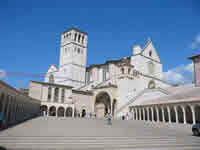 |
 |


 
|
| DAY TRIPS ORVIETO ASSISI |
| |
|

.jpg)
|
THIS TRIP BIGINS AND CONCLUDES IN ROME UNLESS OTHERWISE INDICATED BY OUR CLIENT. DIFFERENT RATES WILL BE APPLIED IF DAY TRIP DOESN’T START OR ENDS IN ROME CITY.
We will pick you up at your hotel or wherever you wish by our air conditioned vehicles.
Our skilled multilingual driver guides will show you the most interesting places of the city by giving you the key information from the car without coming within sites.
Qualified stores for shopping will be suggested.
DAY TRIP TO ORVIETO and ASSISI (12 Hrs from 07:00 or 08:00 A.M.)
Driving from Rome through Lazio and Umbria regions we will reach ORVIETO in about 1:30 Hr. and we'll stop in ORVIETO in front of the Gotic Cattedral.
Time at disposal for shopping (Ceramics and White Wine ) then departure to ASSISI (reachable in 1:30 Hr from Orvieto).
At the beginning visit to PORZIONCOLA located at Santa Maria degli Angeli Basilica, then St. Francis Basilica (Basilica di San Francesco di Assisi).
Ending of the trip at St. Clare Church (Chiesa di Santa Chiara). Time for shopping and lunch in a typical restaurant. In the afternoon you'll be driven back to Rome City. |
|
| OUR FLEET |
 |
 |
 |
Mercedes E Class
or equivalent up to 3 pax |
Mercedes Vito/Viano
or equivalent up to 5 pax |
Mercedes Sprinter
or equivalent up to 8 pax |
| 420 € |
450 € |
500 € |
Price includes driver guide for whole tour and does not include gratuities
Accepted payments: U.S. Dollars,Euro, Traveller's cheques.
Prices include driver guide for whole tour |
|
|
| ORVIETO |
.jpg)
|
The ancient city, populated since Etruscan times, has usually been associated with Etruscan Velzna, but some modern scholars differ. Orvieto was certainly a major centre of Etruscan civilization; the Archaeological Museum (Museo Claudio Faina e Museo Civico) houses some of the Etruscan artifacts that have been recovered in the immediate neighbourhood. An interesting survival that might show the complexity of ethnic relations in ancient Italy and how such relations could be peaceful, is the inscription on a tomb in the Orvieto Cannicella necropolis: mi aviles katacinas, (I am of Avile Katacina), with an Etruscan-Latin first name (Aulus) and a family name that is believed to be of Celtic The territory of Orvieto was under papal control long before it was officially added to the Papal States; it remained a papal possession until 1860. (Catacos) origin.
Orvieto is noted for its Gothic cathedral, or duomo. The church is striped in white travertine and greenish-black basalt in narrow bands; its design has often been attributed to Arnolfo di Cambio, but the prevailing modern opinion is that its master mason was an obscure monk named Fra' Bevignate from Perugia; construction began in 1290. The façade (illustration, right) is particularly striking and includes some remarkable sculpture by Lorenzo Maitani (14th century). Inside the cathedral, the Chapel of San Brizio is frescoed by Fra Angelico and with Luca Signorelli's masterpiece, his Last Judgment (1449-51). On the left side of this chapel are the tombs of the Gualterio family.
|
| ASSISI |

|
Assisi , is a town in Italy in province of Perugia, Italy, in the Umbria region, on the western flank of Mt. Subasio. It is the birthplace of St. Francis, who founded the Franciscan religious order in the town in 1208, and St. Clare (Chiara d'Offreducci), the founder of the Poor Clares. Saint Gabriel of Our Lady of Sorrows of the 19th century was also born in Assisi.
Around 1000 BC a wave of immigrants settled in the upper Tiber valley as far as the Adriatic Sea and also in the neighbourhood of Assisi. These were the Umbrians, living in small fortified settlements on high ground. From 450 BC these settlements were gradually taken over by the Etruscans. The Romans took control of central Italy by the Battle of Sentinum in 295 BC. They built the flourishing municipium Asisium on a series of terraces on Mount Subasio. Remains from these Roman times can still be found in Assisi: city walls, the forum (now Piazza del Comune), a theatre, an amphitheatre and the Temple of Minerva (now transformed into the Church of Santa Maria sopra Minerva).
The Basilica of San Francesco d'Assisi (St. Francis) is a World Heritage Site. The Franciscan monastery, il Sacro Convento, and the lower and upper church (Basilica inferiore e superiore) of St Francis were begun immediately after his canonization in 1228, and completed 1253. The lower church has frescos by renowned late-medieval artists Cimabue and Giotto; in the Upper church are frescos of scenes in the life of St. Francis by previously ascribed to Giotto and now thought to be by artists of the circle of Pietro Cavallini of Rome.
The Basilica was badly damaged by the earthquake of September 26, 1997. Part of the vault collapsed, killing four people inside the church and carrying with it a fresco by Cimabue. The edifice and was closed for two years for restoration.
Porziuncola, is a small church in the frazione of Santa Maria degli Angeli, situated about 4 kilometers from Assisi, Umbria (central Italy). It is the place from where the Franciscan movement started.
The name Porziuncola (meaning small portion of land) was first mentioned in a document from 1045, now in the archives of the Cathedral of San Rufino, Assisi.
The Basilica of Saint Clare, located in Assisi, is the 13th century church that is dedicate to and contains the remains of Saint Clare of Assisi, a follower of Saint Francis of Assisi and founder of the Order of Poor Ladies, known today as the Order of Saint Clare.
Construction of the church begun under the direction of Filippo Campello, one of the foremost architects of the time. On 3 October 1260, Clare's remains were transferred from the chapel of San Giorgio to the Basilica of Saint Clare where they were buried in the earth under the high altar of the new church.
|
| |
|
|
 |
 |


![]()
![]()
![]()

.jpg)



.jpg)
